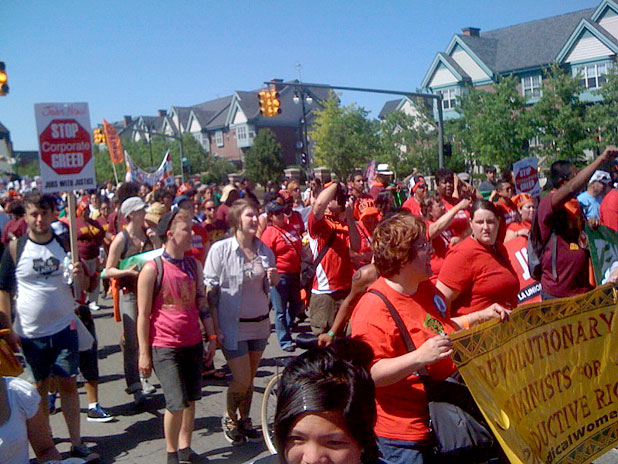 SocialForumists taking to the streets of Detroit. (Tom Philpott)
SocialForumists taking to the streets of Detroit. (Tom Philpott)
DETROIT, MICH. — As the economy falters, another war lurches into chaos, and our nation’s gravest environmental calamity plays out in slow motion at the rate of at least one Exxon Valdez spill per week in the Gulf, a kind of sour despair has taken root in progressive circles.
“Where is the left?,” David Roberts asked in a plaintive recent essay. The question is a fair one. Where are the protests, the convulsions of dissatisfaction and outrage, the polemics, the visions of something different and better? So far, at least in media coverage, popular outrage has been monopolized by the far right Tea Party, who prescribe a whopping dose of more of the same — deregulation, tax cuts, “drill, baby, drill” — to cure what ails us.
Well, I think I might have found the left: in plain sight on the streets of Detroit, a kind of sacrifice zone for 30 years of deindustrialization and suburbanization. Detroit is the current site of the second U.S. Social Forum, a convergence of social movements from around the country rallying around the undeniable premise that “another world is possible [and] another U.S. is necessary.”
The idea of “social forums” grew out of the movement against corporate-led globalization that gained force at the WTO protest in Seattle a decade ago. Rather than gather merely to react to intergovernmental policy that props up vast, transnational global companies answerable only to their shareholders, why not get together to germinate and discuss alternatives as well? World Social Forums have been convened since then in Mexico and India; the first U.S. Social Forum happened in Atlanta in the summer of 2007.
The expected crowd for this week’s events is at least 30,000 strong. On Tuesday, untold thousands of people marched down Detroit’s storied Woodward Ave — the city’s main transport thoroughfare, running the length of Detroit and dividing the city into east and west. A bustling streetcar once carried the city’s working-class population to its car factories along Woodward. First the streetcar vanished, then the car factories, and now Woodward Avenue belongs exclusively to cars made elsewhere.
But on a blistering hot Tuesday afternoon, it was the cars that got the boot. In their place, a raucous, joyous line of people stretched down Woodward as far as the eye can see: no despair in sight. There were anarchists, feminists, anti-warriors, poor-people’s advocates, disabled activists, queers, people thundering against the bank bailouts and the persistent lack of jobs. There were climate activists, urban farmers, and community organizers.
The solutions are on the ground, in front of our faces, everywhere where communities are rallying to create human-scale, accountable alternatives to destructive Big Food.
My own protest experiences have mostly been about negation: for example, in the early 1990s, helping rally my fellow University of Texas students against a corrupt and compromised president. Embarking on the march, I admit I was confused: who were we rallying against, who were we going to confront?
But as I moved along with the crowd down Woodward, the logic of what we were doing emerged: We were creating, right there in the post-industrial America’s capital city, the “other world” suggested in the Social Forum’s slogan. At several points in the several-mile hike toward downtown, marching bands erupted into cacophonous, beat-driven music, lashing the crowd into a frenzy of laughter and dancing.
In her book A Paradise Built in Hell, Rebecca Soltnit writes of the strange utopias that tend to arise in disaster: the way when some horrific shock strikes, people often band together and form close-knit, ad hoc communities. The mood on the street in Detroit that afternoon — a broadly diverse group of people united in a kind of informal, antic solidarity — made me think of Solnit’s insight. The point of the Social Forum is not just to rail against the current order, but also to create, right here in the street, in the moment, the solutions to the problems that plague us: reliance on ecosystem-destroying fossil fuels; debt-driven, dead-end consumerism; economic stagnation; intractable foreign misadventures, etc.
As a food-politics writer, I’ve seen over and over again that the solutions to the deep dysfunctions of our food system don’t ultimately lie in some Congressional committee or Oval Office brain trust. The solutions are on the ground, in front of our faces, everywhere where communities are rallying to create human-scale, accountable alternatives to destructive Big Food. The politicians will continue to defend the incumbent industries that benefit from the status quo — the agrichemical giants, the fast-food behemoths, etc. — unless and until the social movements gain critical mass on the ground, on the street.
I often lapse into a kind of quiet despair that this will ever happen. Industrial food is too cheap, too ubiquitous, too easy. It offers fast gratification, and its devastations transpire in slow motion, easily put out of sight and out of mind. But here in Detroit, the city where America’s industrial tradition died and a new tradition of what might be called post-industrial urban agriculture is emerging, I’m finding some (hard-won and tentative) hope.
I’m off now to plunge into the Social Forum, with its hundreds of workshops organized by an array of organizations, from established NGOs like Sierra Club and Food and Water Watch to neighborhood-scale groups from around the country. I’ll report back soon.




